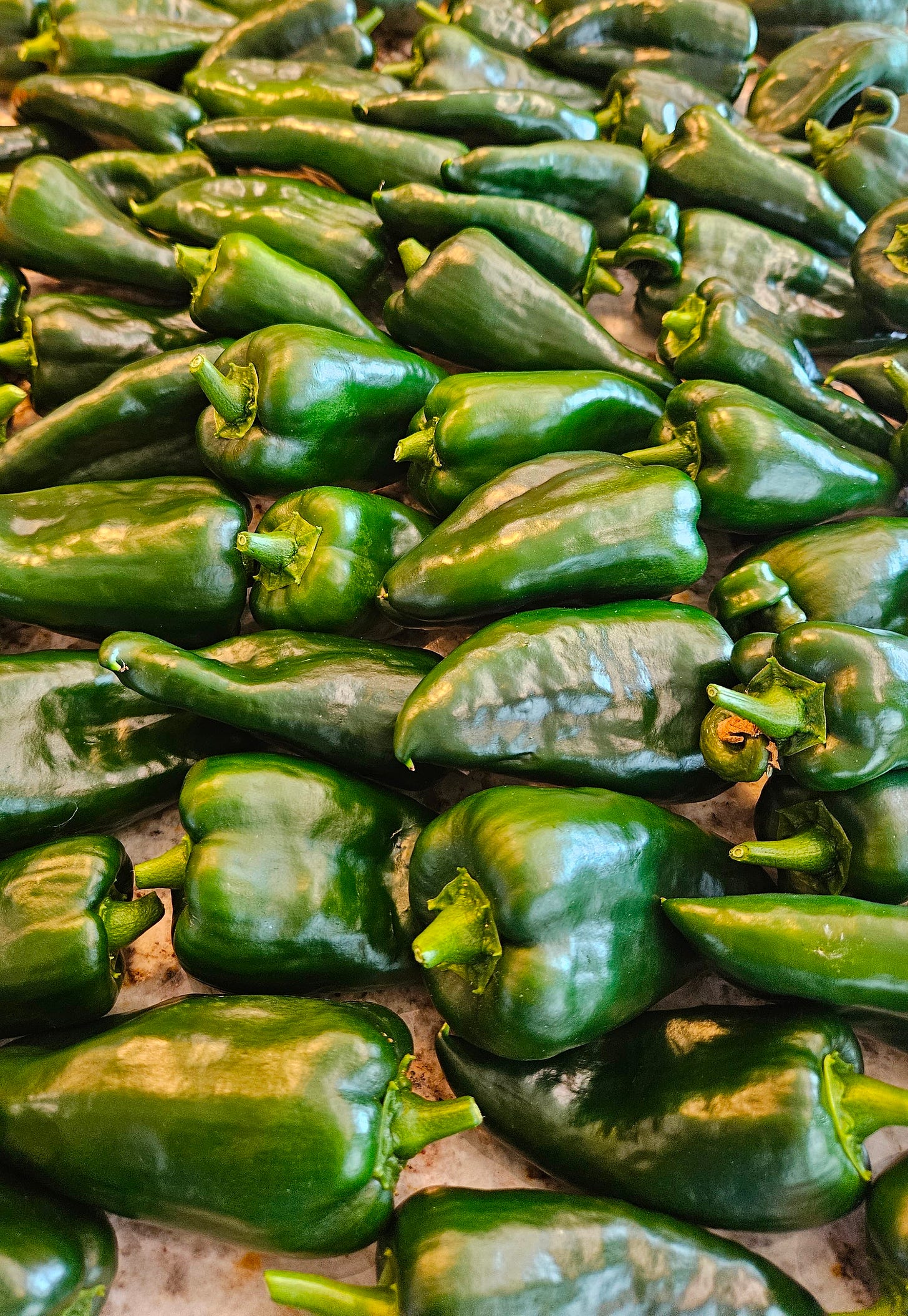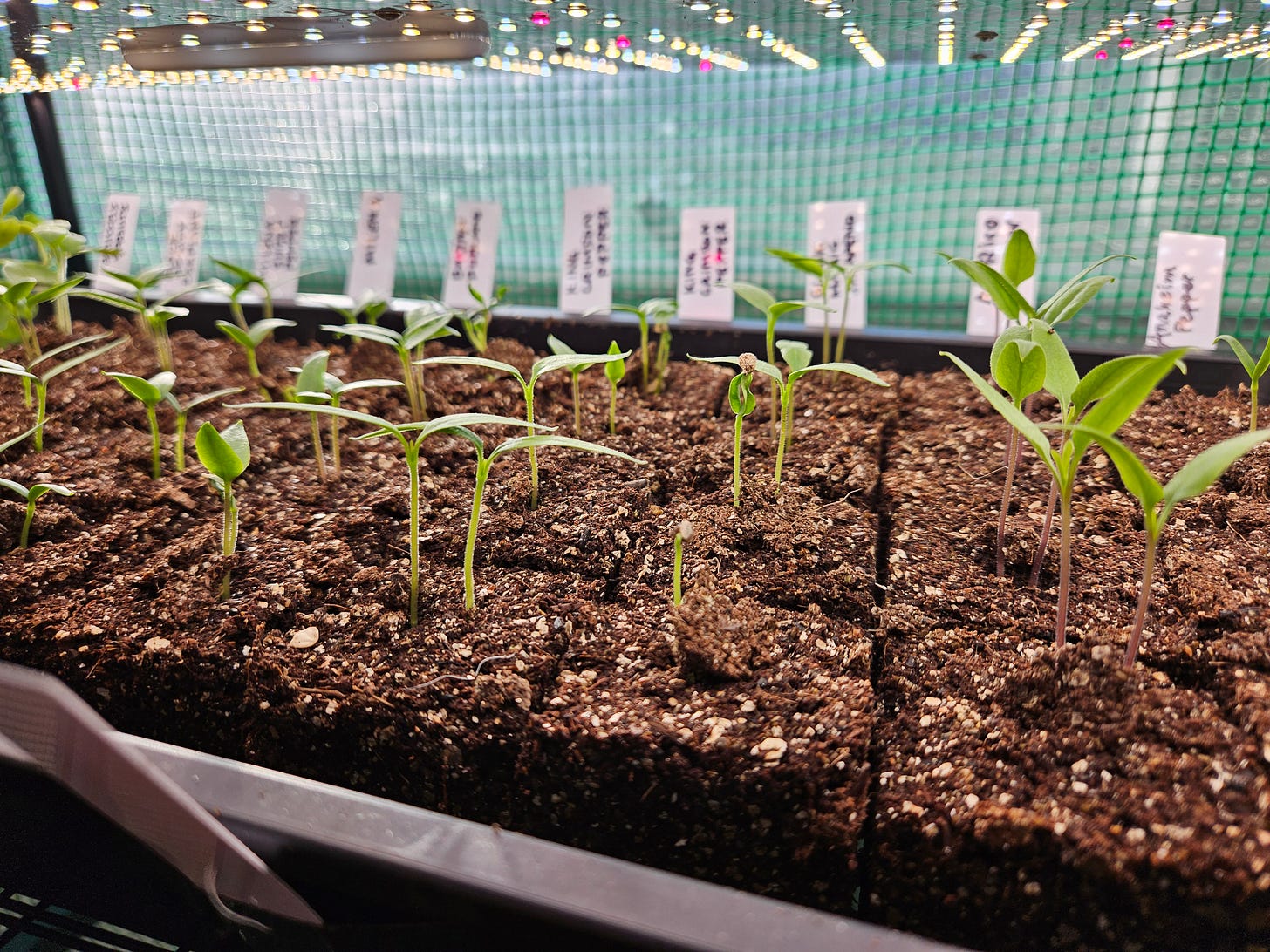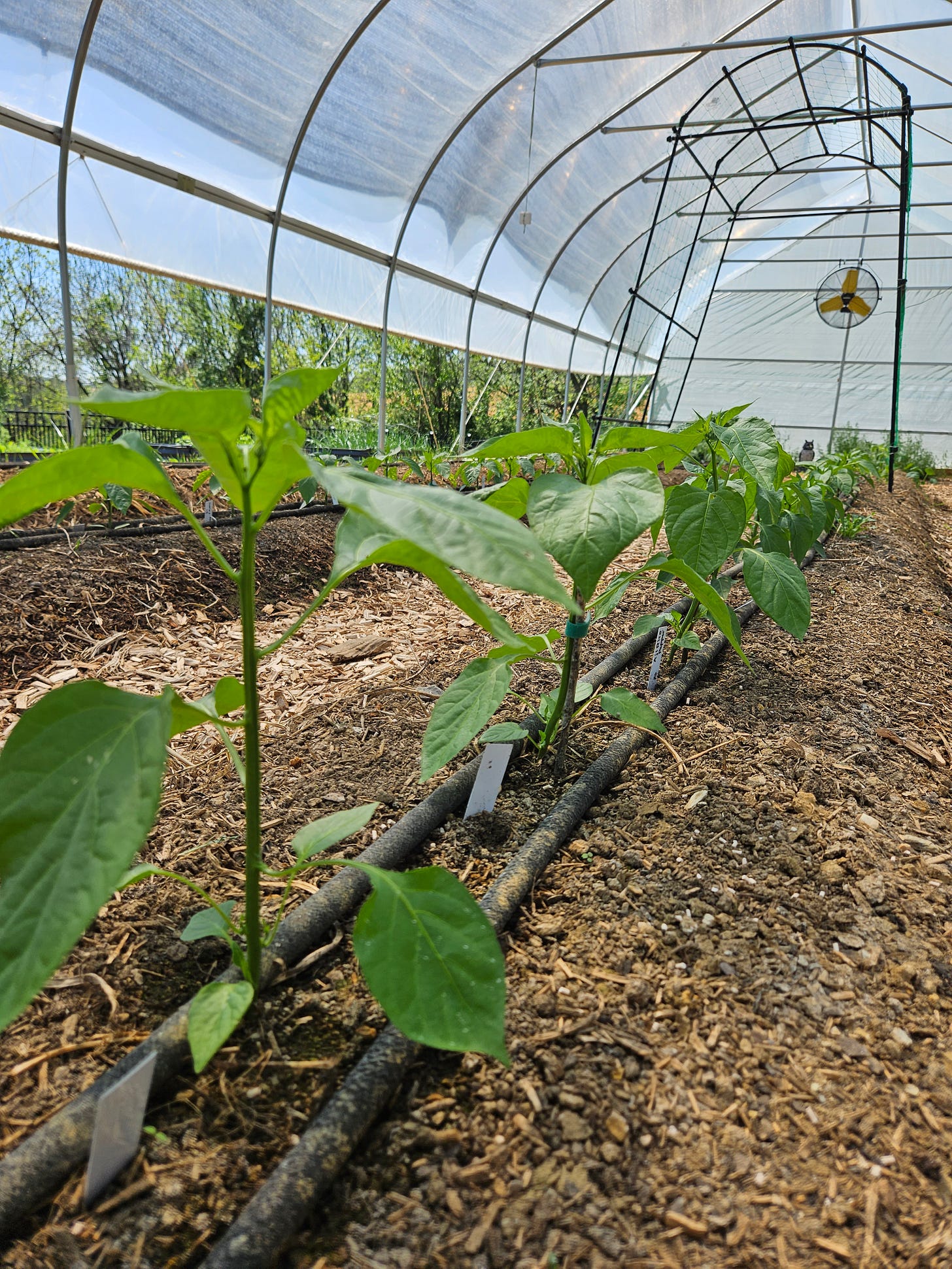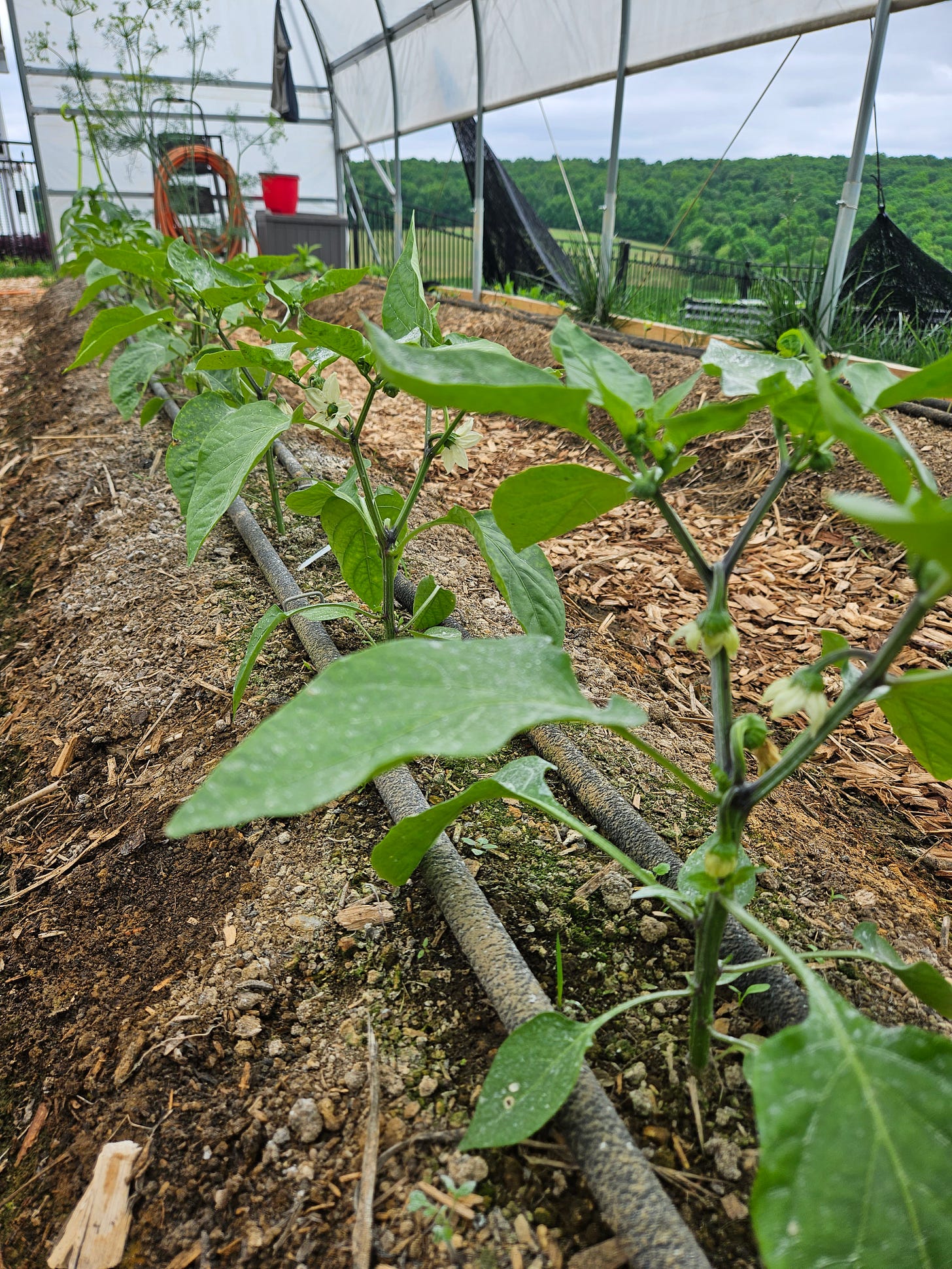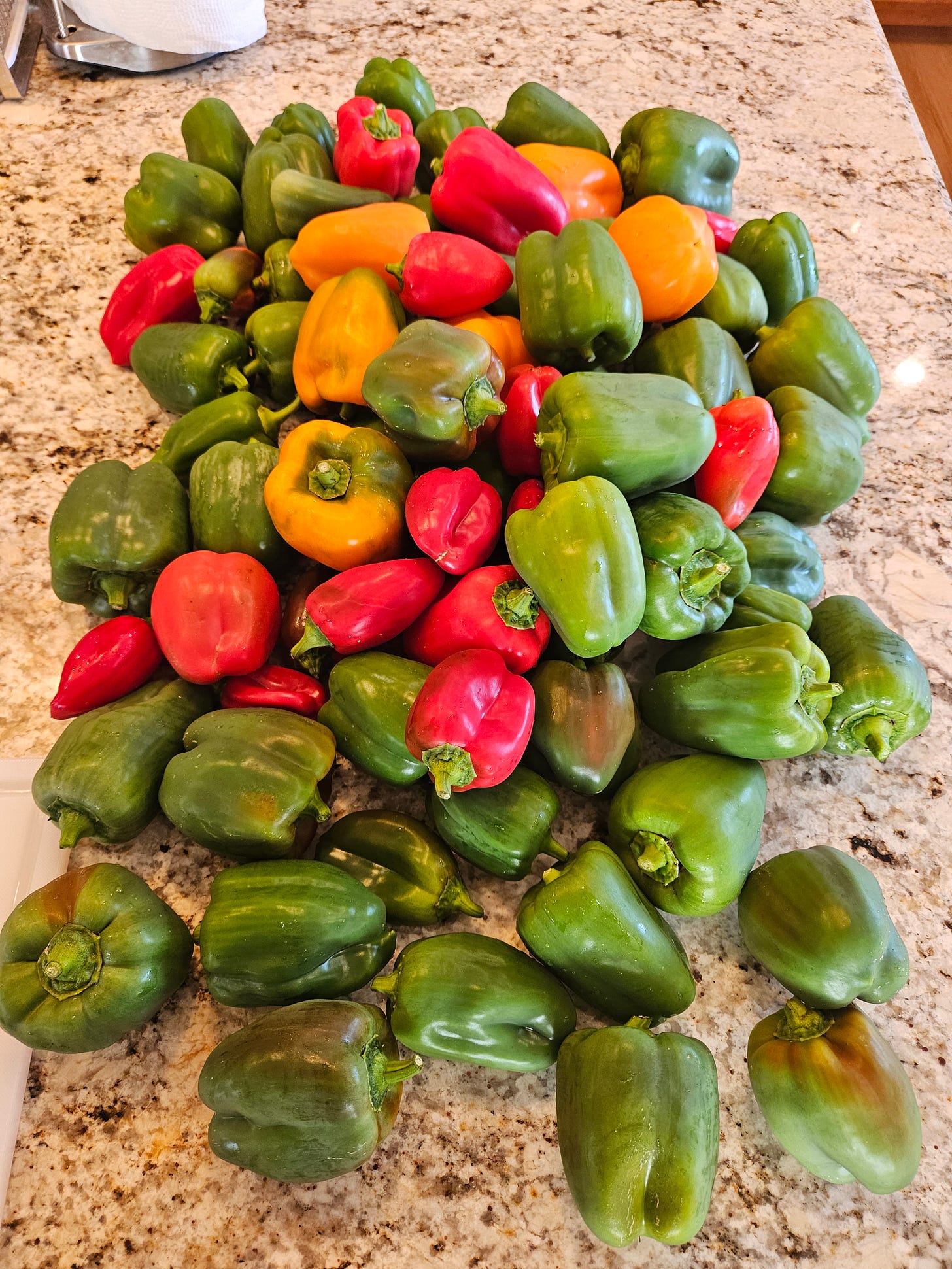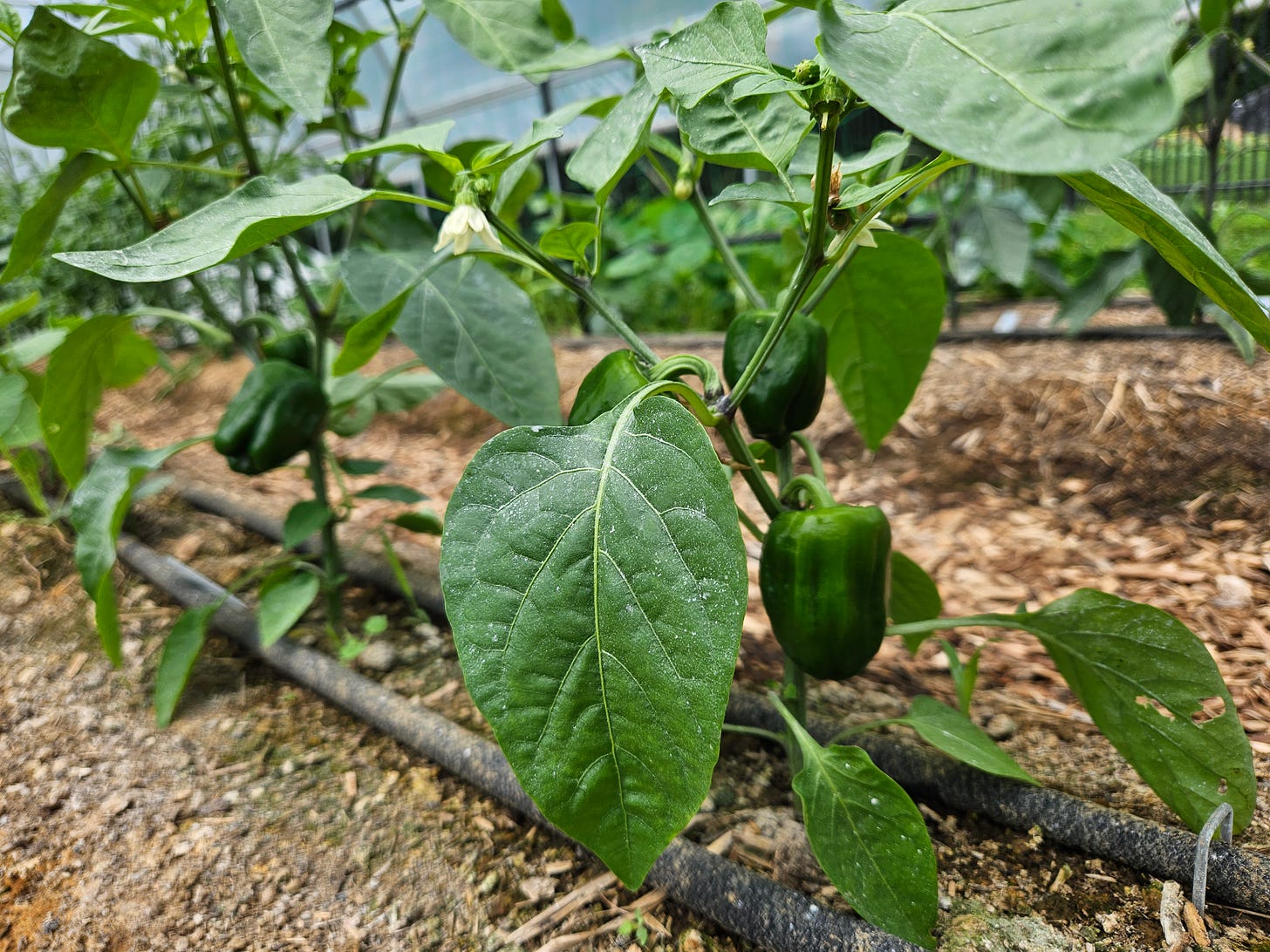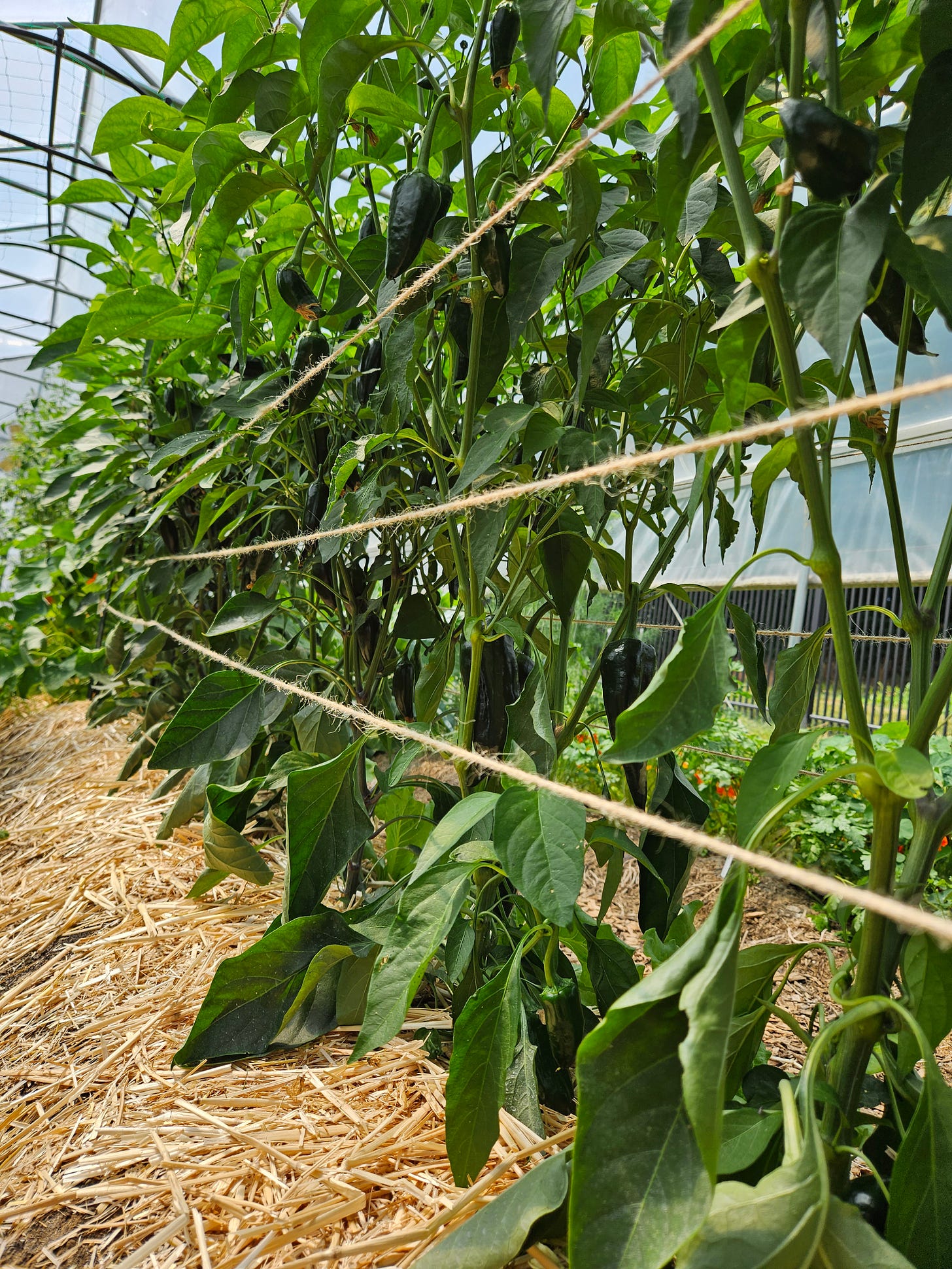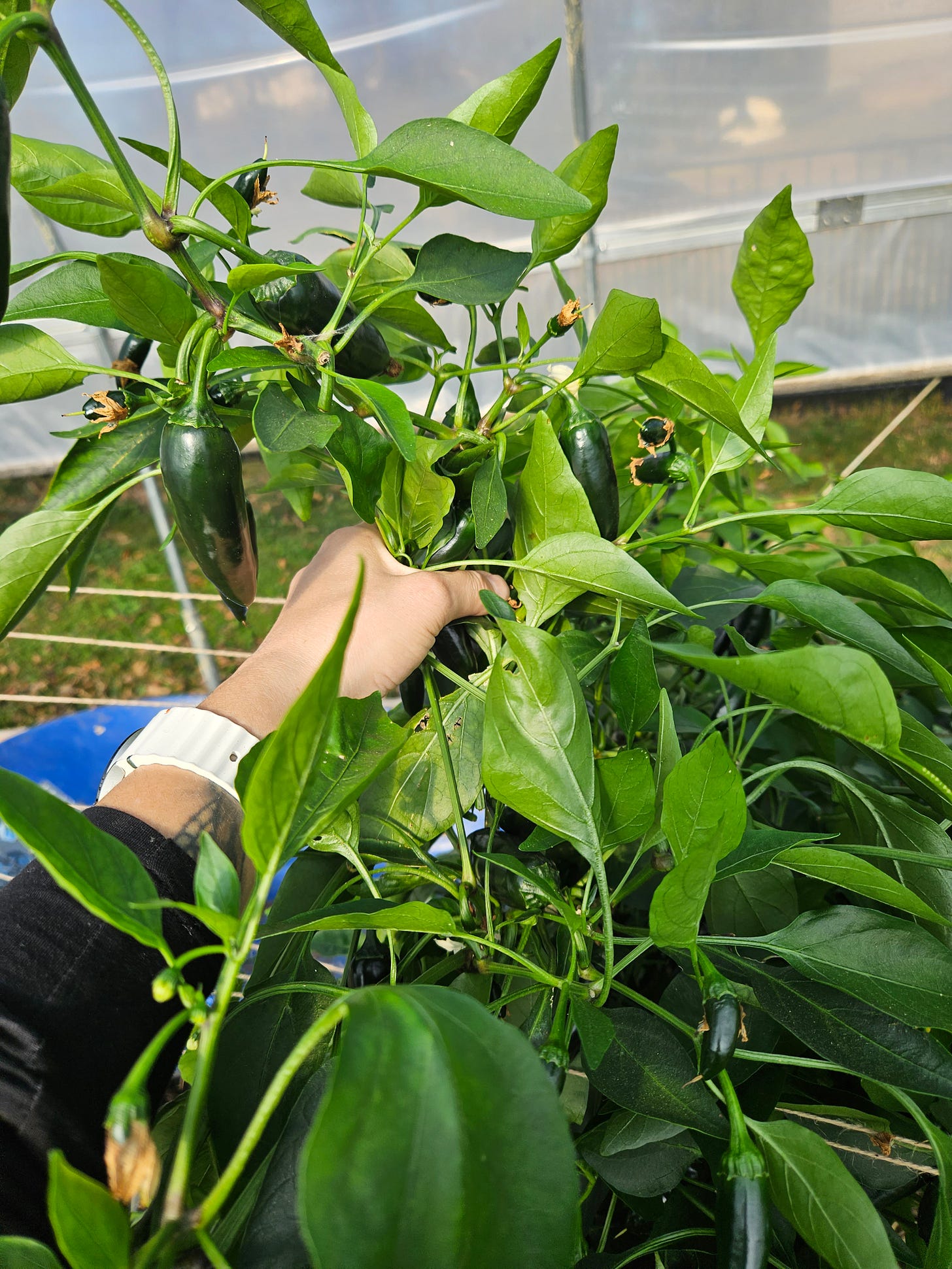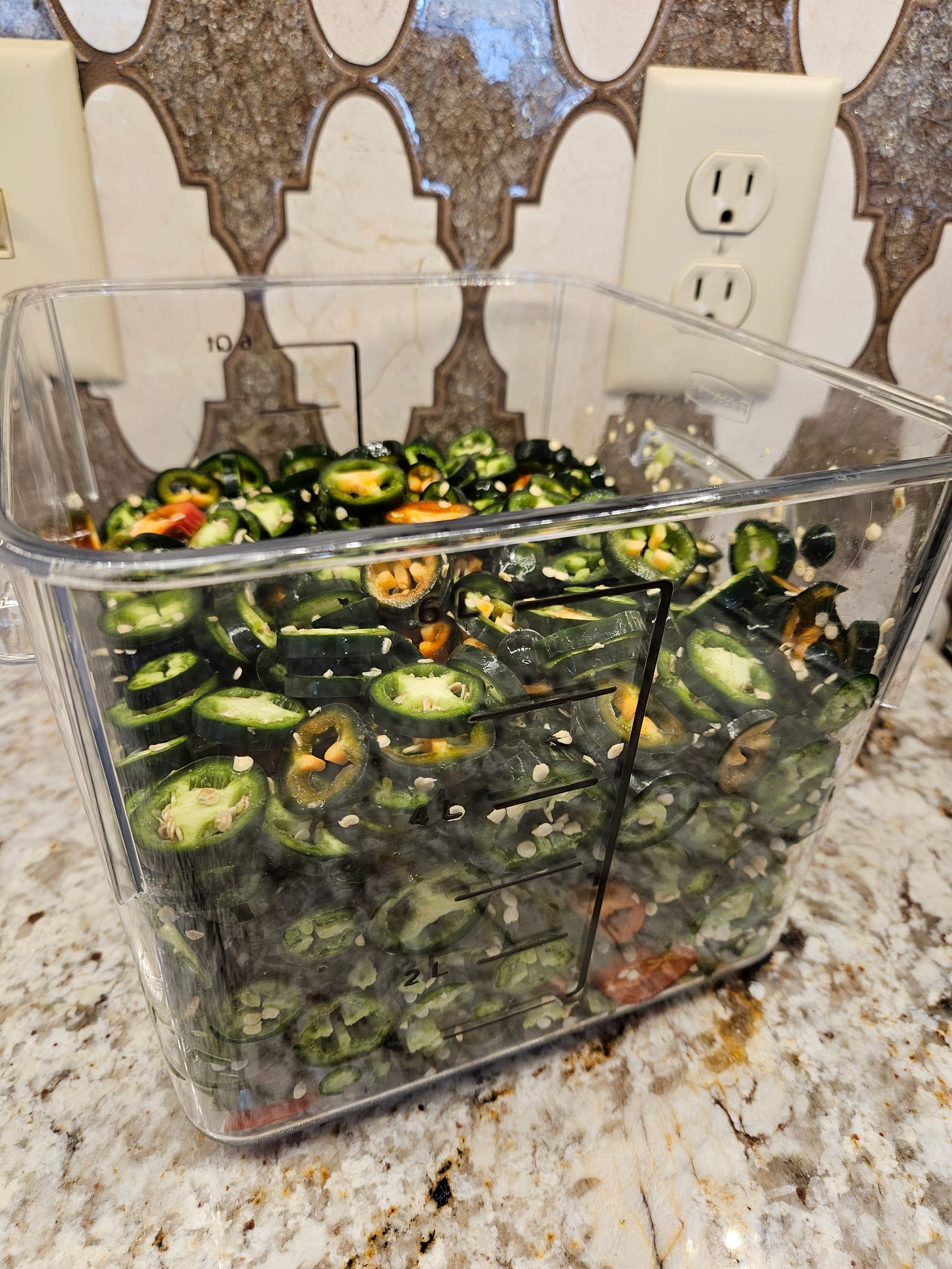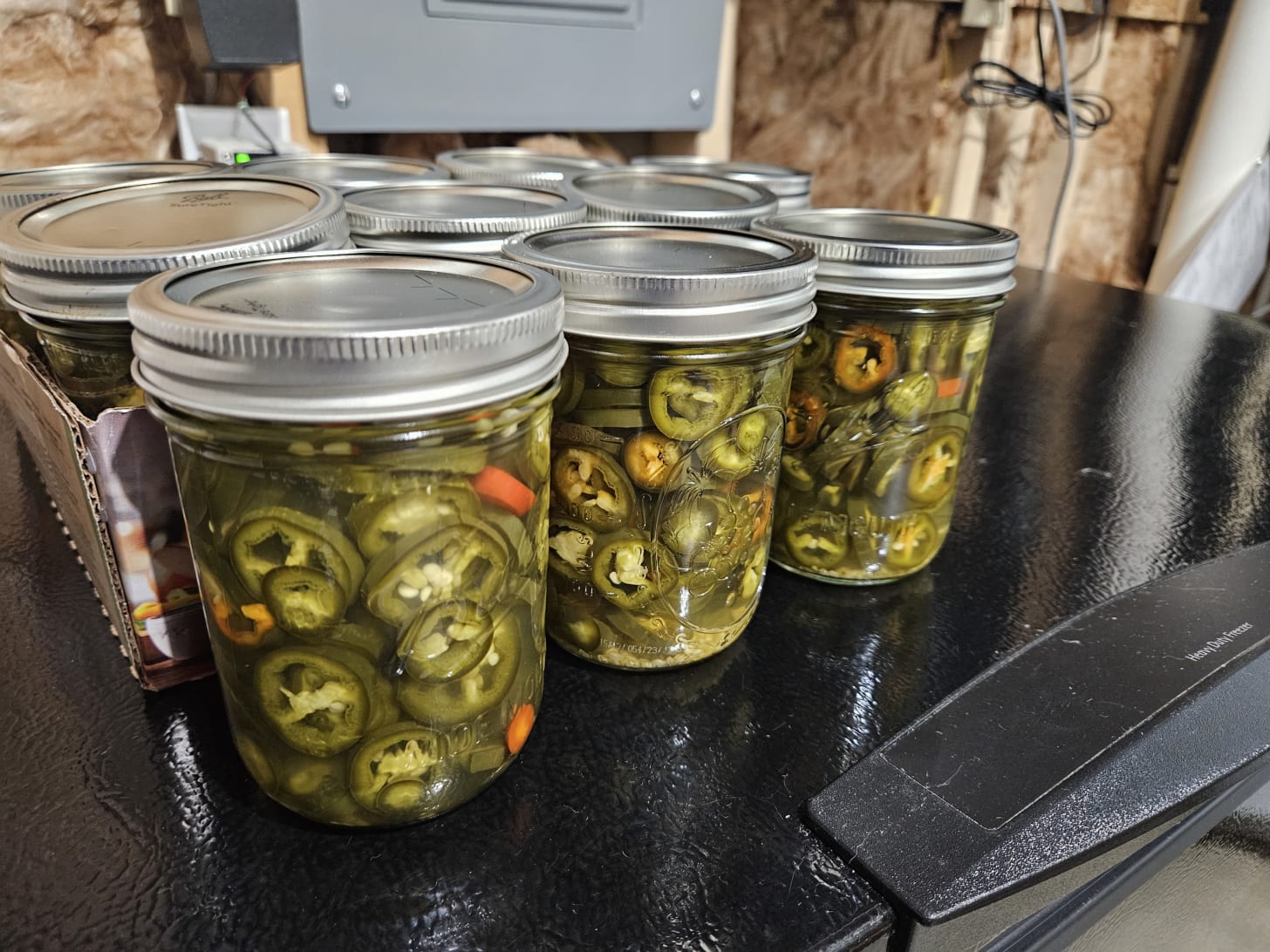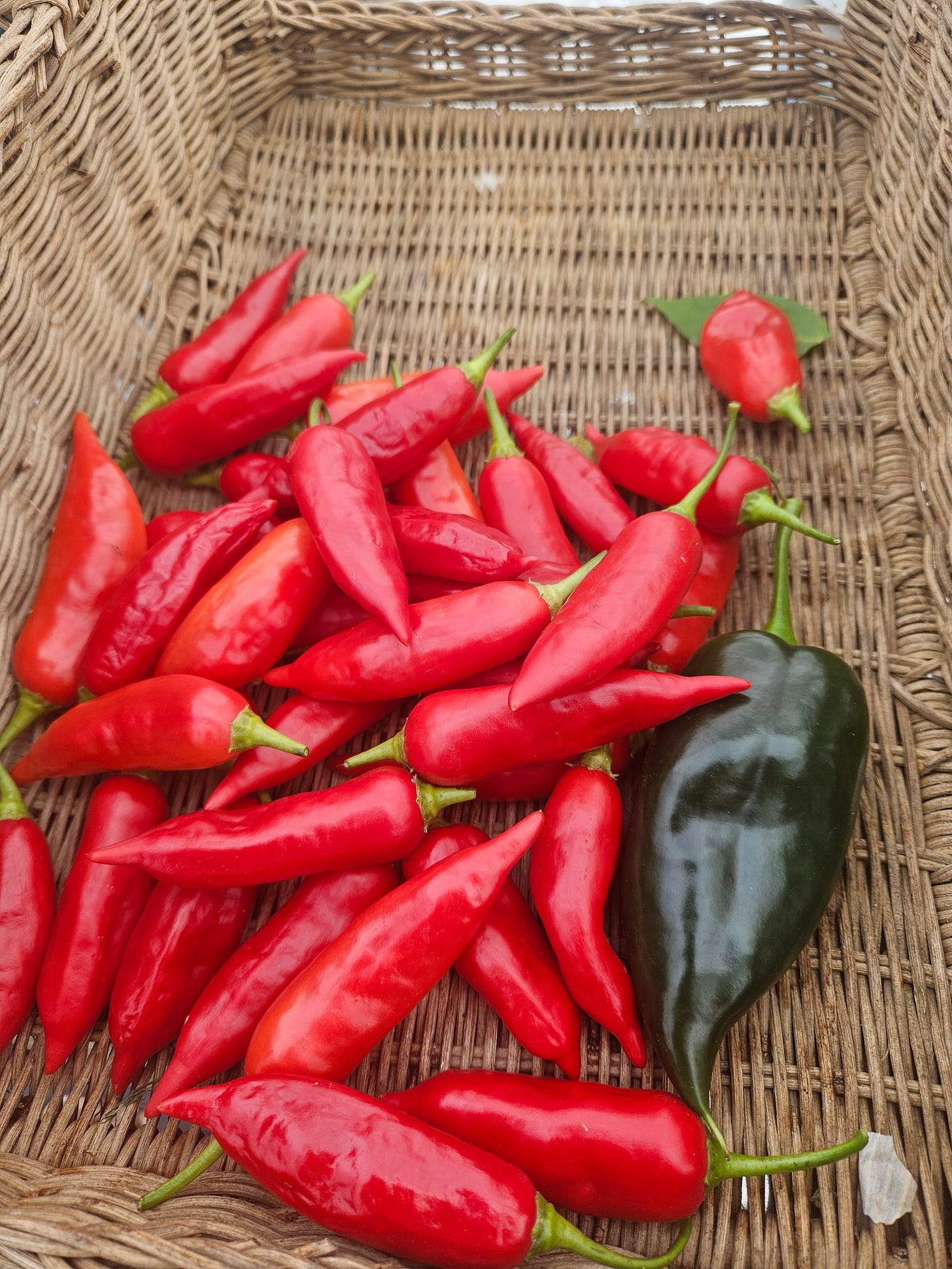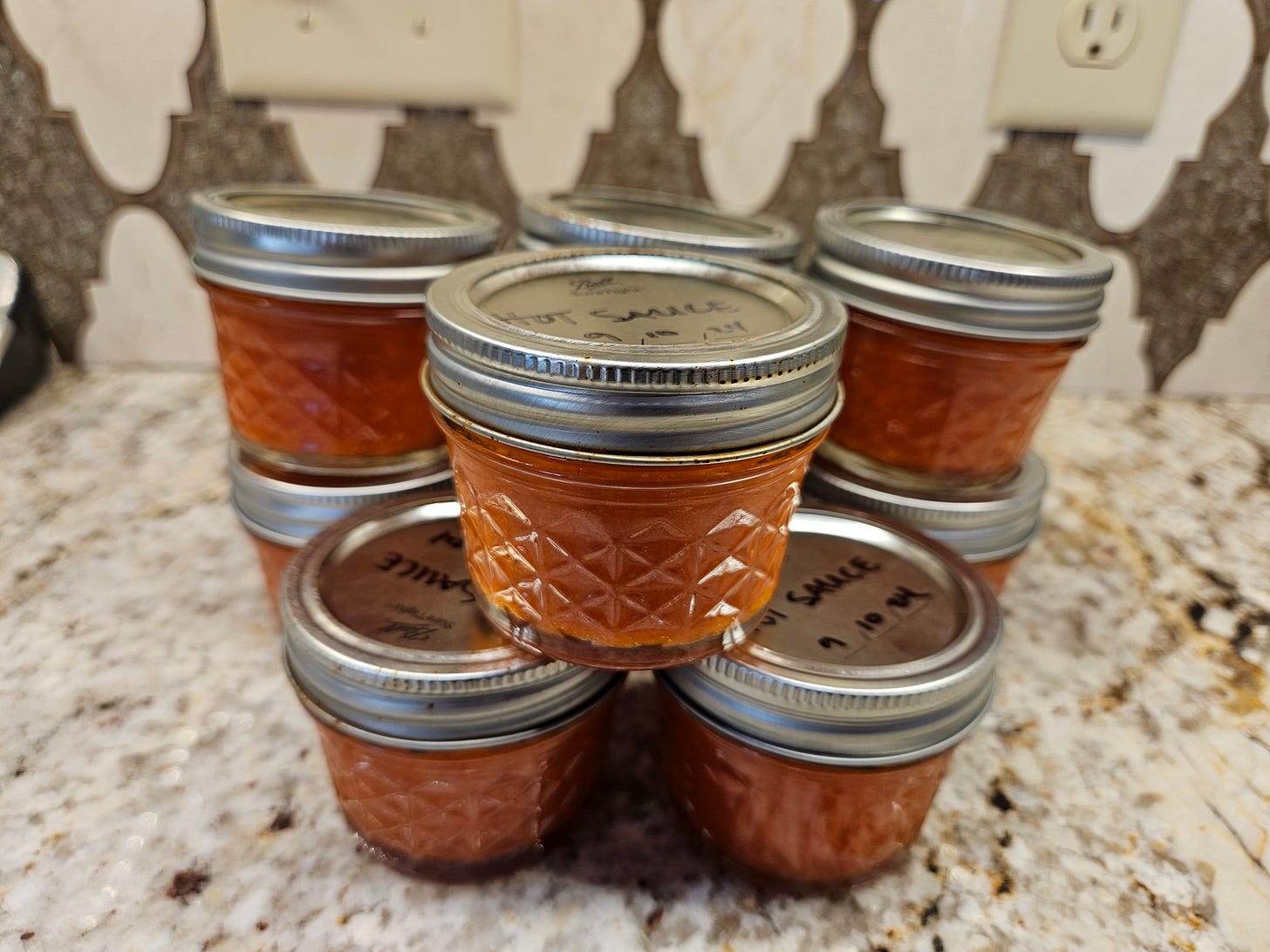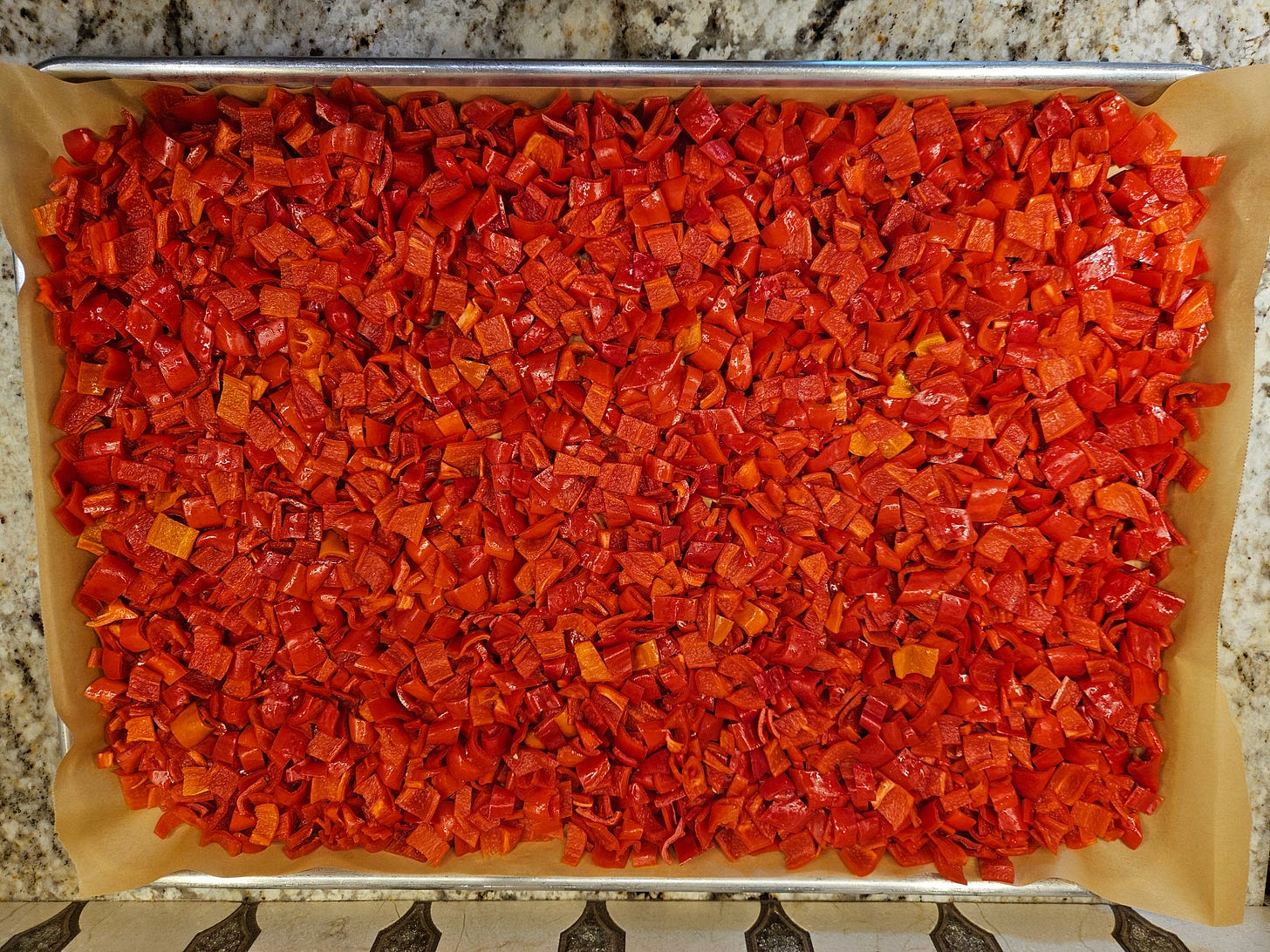Everything I Grew in 2024: Part Four
Peppers
2024 was an unusually good year for peppers in my garden. I was able to can over twenty pints of Summer salsa, dozens of pints of roasted red peppers and poblanos, and freeze over twenty pounds of diced peppers. Needless to say, we won’t be running out of peppers anytime soon! After a season like that, I’ve reflected on what worked, what didn’t, and how I can improve for 2025.
This is part four of the “Everything I Grew” series, where I review the varieties I grew in 2024, share my likes and dislikes, lessons learned from the mistakes I made, and reveal any new varieties that I’m growing this year.
Capsicum annuum
Peppers are a beloved Summer staple in my house. Whether they’re sweet, smoky, or spicy, they are in demand in our kitchen. With their long growing season and high productivity, peppers are rewarding but can also be a bit tricky to manage. This year, I learned a lot about balancing varieties, improving trellising, and knowing when enough is enough—especially when it comes to hot peppers!
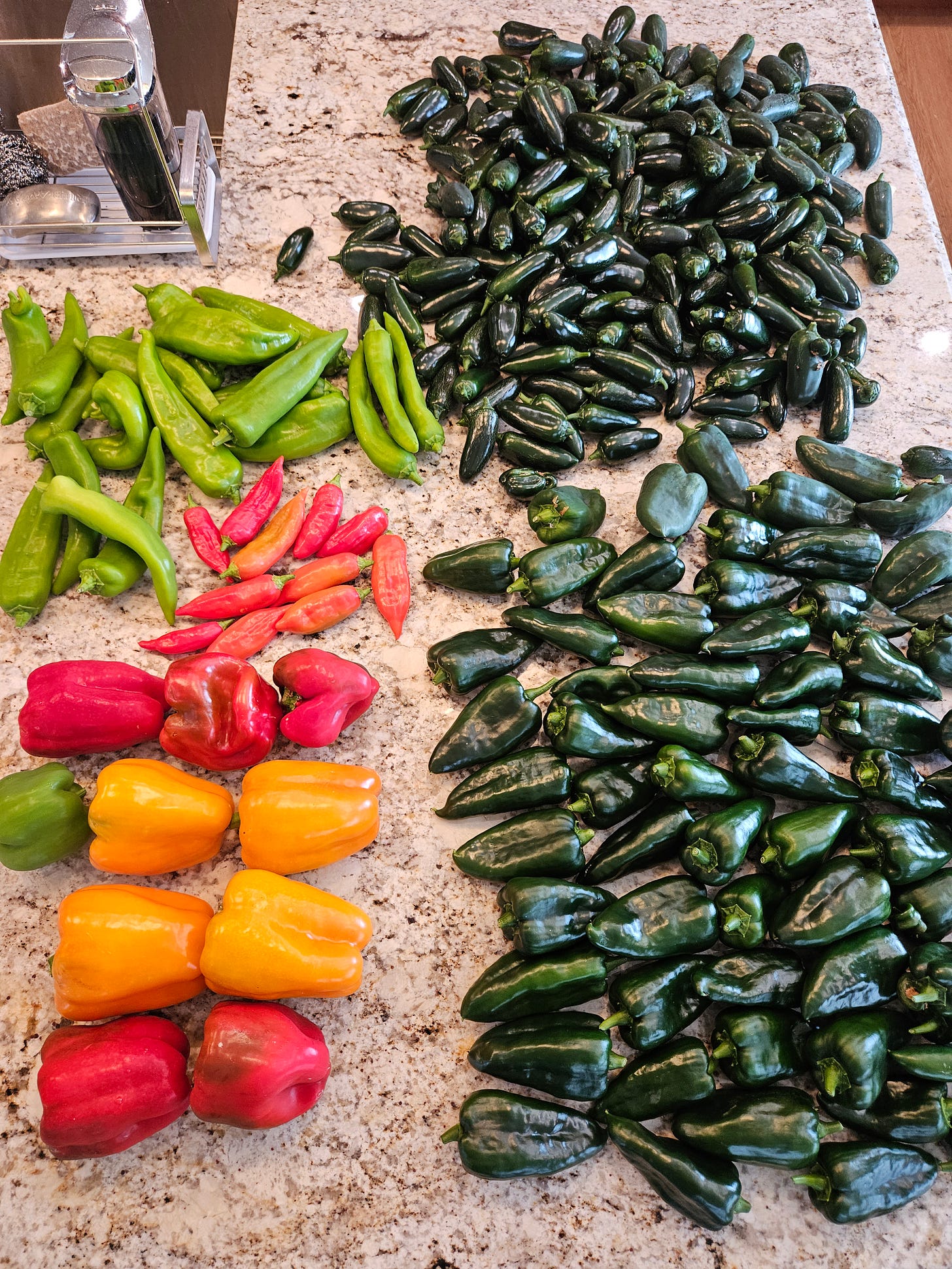

Last year, I started my peppers indoors toward the end of February.
Since I have a hoop house, and because the peppers are planted there annually, I am able to transplant my peppers out a few weeks before what is typical in my zone (7a). The hoop house keeps daytime temperatures reliably higher and wards off cold Spring winds, providing a better environment for heat-loving peppers.
By May 2nd, my peppers were transplanted into the garden and had grown considerably:
And two weeks later, there were the first flowers and fruit buds:
By the end of May, I’d normally have straw mulch spread around the base of my pepper plants. But last year, we experienced an unusually wet Spring that lingered well into early Summer. I held off on mulching, worried it would trap too much moisture in the soil and attract slugs. Instead, I waited until things dried out before adding the mulch.
Peppers, like other nightshades, are known as heavy feeders. Typically, when mulching, I would also apply a side dressing of fertilizer, such as FoxFarm’s Tiger Bloom (2-8-4), to support flowering and fruiting. However, since my Fall/Winter 2023 soil test revealed that the soil was already nutrient-rich, I skipped fertilizing this year.
Even though peppers aren’t vining plants like tomatoes, they still need support to handle the weight of their fruit. In 2023, I staked each plant individually. While it worked, it was a tedious and time-consuming process. This year, I decided to try a different trellising approach, which came with both benefits and drawbacks.
Instead of staking each plant, I opted for a “box” method. Since my peppers are planted in two long rows, I used four t-posts and garden twine to form a rectangular frame around each row. This way, the entire row was supported by a single structure rather than individual stakes.
As the peppers grew, I added new levels of twine to contain them.
This trellising method worked reasonably well. It kept the pepper plants mostly contained, and the layers of twine did a decent job supporting branches that extended outward from the rows. The plants also helped support each other’s branches along the sides. Overall, compared to staking each plant individually, the “box” method was a big improvement—though there’s definitely room for refinement.
Next year, I plan to improve the system by placing t-posts at five-foot intervals along each row, which should help prevent the twine from sagging and offer better overall support. I’ll also be switching to taller t-posts. The ones I used this year stood four feet above the ground after being pounded in, but some of my pepper plants grew well over five feet tall (a height I didn’t even know they could reach!), causing them to spill over the top. The taller posts should help keep everything upright and more contained.
Mistakes
As I mentioned at the start, I had an incredible pepper year. Honestly, I don’t think it was due to anything special I did—sometimes, the weather just cooperates, or the conditions aren’t favorable for pests. Aside from trying a different trellising method in 2024, I didn’t change much in my approach. While I’d love to take full credit for the success, I think the best thing I did was simply not get in the way.
As for the mistakes I made with the peppers this year, they are mostly confined to the harvest. For some reason, I didn’t learn my lesson in 2023 after growing five habanero and ten shishito plants. Smaller pepper varieties—like habaneros, shishitos, and jalapenos—pump out tons of fruit over a very long period of time. In 2023, we were drowning in shishitos and habaneros and, of course, nobody we knew wanted these lesser known (and, in the case of habaneros, outrageously hot) peppers. We tried to eat them all, but ultimately composted more than I’d like to admit.
This year, I made a similar mistake—though thankfully, not as extreme. While bell peppers are the variety we eat most often, they were also the variety we got the least of in 2024. Meanwhile, we were overloaded with everything else, including yet another hot pepper variety that gave me flashbacks to my habanero surplus. It wasn’t a terrible problem to have, and overall, I’m more than happy with the bounty. That said, I’ll be much more deliberate during the planning process this year, paying close attention to how many plants I grow for each variety to better match what we’ll actually use.
Now, on to the varieties.
Bell Peppers
I grew two varieties of bell pepper in 2024; one old and one new. The old is a trusty red bell pepper, King Crimson, and the new was a promising choice suited for polytunnel production—and a new favorite.
King Crimson
I was drawn to this variety back in 2022 because it matures faster than most bell pepper varieties. Anyone who has grown bell peppers knows how much they can test your patience—especially if you prefer to wait until they’re fully ripened rather than picking them green. They can linger on the plant for weeks, showing little change in size or color. King Crimson, however, promised green peppers in just sixty days, offering a major head start for red bell peppers.
So, far, this variety has not disappointed. The plants are pretty small, but they rapidly get covered in peppers.
The King Crimson peppers are on the smaller side, reaching only about three to four inches in length, but their flavor is exactly what I want from a red bell—sweet, crisp, and delicious.
Milena
While browsing through the seed catalog in the Winter of 2023, my husband and I both immediately agreed on this orange bell pepper variety—it was an easy choice. Not only were we looking to grow more bell peppers, but we also wanted to add a yellow or orange variety to the garden. Milena stood out, thanks to its extensive disease resistance package and its promise to tolerate heat and thrive in protected environments like my hoop house (aka polytunnel).
The Milena plants grew significantly larger than the King Crimson variety and produced about twice as many fruit. On top of that, the peppers themselves were larger, beautifully uniform, and have amazing flavor.
Roasted red peppers are something we preserve every year, which you can’t really do with these (we did it anyway) because they don’t have that distinctive red bell pepper taste. However, the Milena peppers do make one of the best fresh eating peppers I’ve ever had and they’re wonderful in cooked dishes, too. The fruit walls are super thick and the peppers are blocky, making them ideal for stuffed bell peppers.
Next year’s varieties
Sadly, King Crimson seeds were not available when I ordered my seeds for 2025 and still aren’t today. So, I had to look around for some viable alternatives. I found three that are extremely promising.
First, there is Nitro which, as the name suggests, grows just as quickly as King Crimson and produces green peppers in sixty days. On top of that, it has a better disease resistance package than King Crimson and yields larger peppers.
Second is Olly. This variety reaches maturity in only fifty-seven days (green) but the pepper are smaller, reaching only three to four inches. On the plus side, they’re supposed to have “exceptionally sweet” flavor and thicker fruit walls than the King Crimson.
Lastly, I wanted to give Sprinter a try. It’s another early variety, reaching maturity in sixty-two days (green). It’s recommended for greenhouse culture, similar to Milena, which indicates it will do well in the hoop house. This one stood out to me because of it’s big and blocky four-lobed fruit.
As you might be able to tell, I’m planning on growing a lot more red bell peppers this year, but I still intend to grow plenty of Milena yellow bells, too!
Smoky Peppers
Anaheim and poblano peppers are what I consider “smoky” types—neither sweet nor particularly hot. They’re not ideal for fresh eating but they absolutely shine in dishes where you want that deep, earthy pepper flavor without overwhelming heat.
I only grew one variety of each, and I’m sticking with the same choices for 2025. As the saying goes, “if it ain’t broke…”
Highlander Anaheim Pepper
Highlander is an early-maturing variety, producing edible peppers in only sixty-five days on massive plants. When I mentioned some of my peppers grew to be well over five feet tall, well, I was talking about the Highlander. High Mowing mentions that this variety gets “tall and large,” but that is a bit of an understatement.
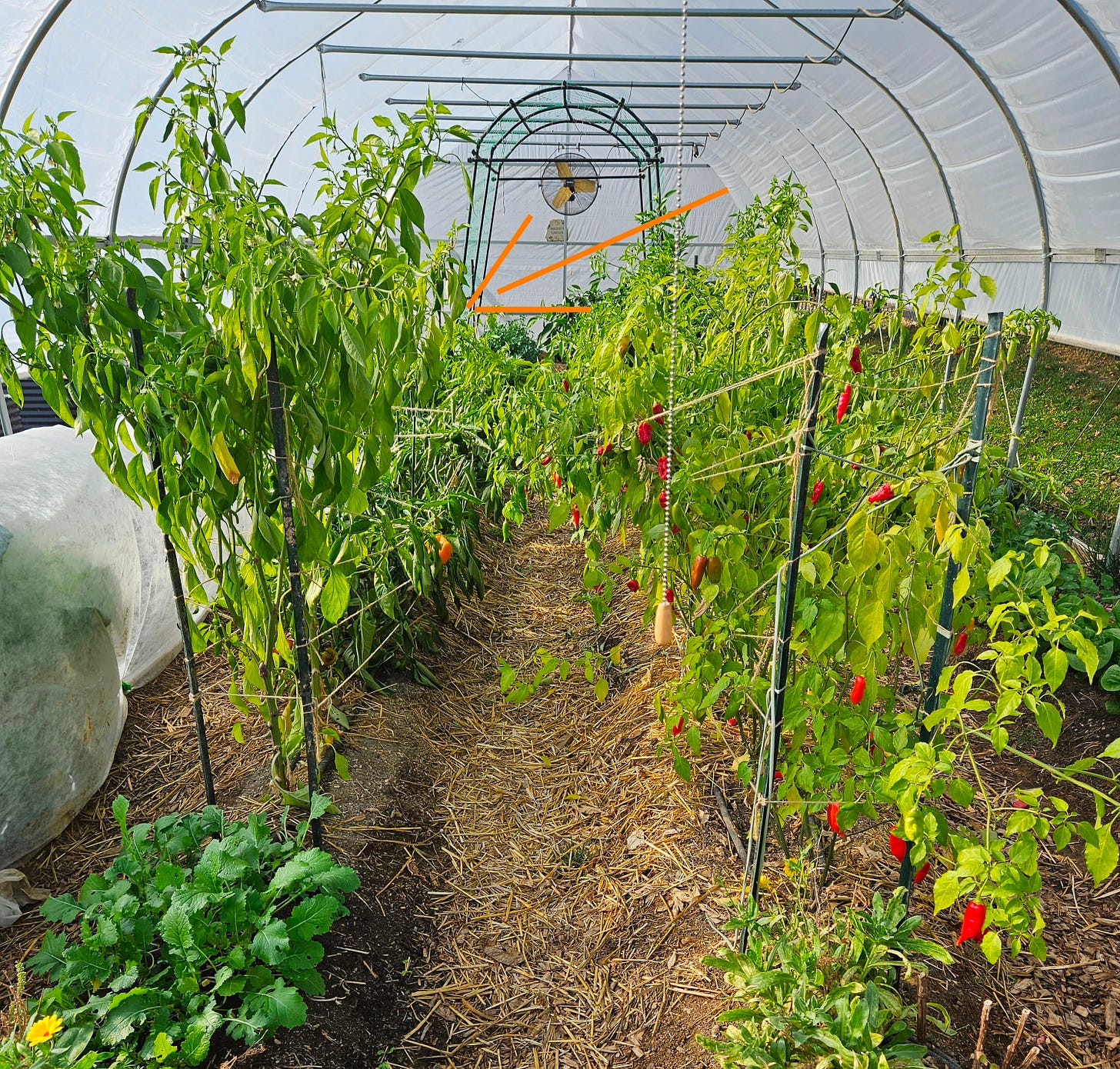
Despite becoming slightly unwieldy, the plants consistently put off tons of uniformly long peppers.
Anaheim peppers are thin-walled and subtly smoky which led to them being chopped up and being used to make chili con queso several times throughout the Summer. They’re also great in egg omelets.
Bastan Poblano
The Bastan variety is my go-to for poblano peppers. Year after year, these plants produce huge yields for me with very little fuss. Poblanos start becoming harvestable in sixty-five days, but you can let them sit on the vine for a few more weeks to harvest a “chocolate” pepper. If allowed to dry, those chocolate peppers become ancho chilis!
The plants are sturdy and upright, and aside from the Highlander variety, they require less trellising than most others. The peppers are beautifully glossy, uniform, and have thick walls—perfect for roasting.
One of our favorite ways to preserve them is by charring the peppers on the grill, removing the skins and seeds, and pressure canning them in water. The grilling process brings out an incredible sweetness, and the char deepens their smoky flavor. These roasted poblanos are fantastic in Mexican rice and any chili-forward dishes we make!
Spicy Peppers
I grew two varieties of hot pepper in 2024 and, like the bell peppers, one was new and the other was a trusted favorite. I always stick to my favorite jalapeno variety—Black Magic—but I tend to experiment with one other hot pepper each year. Last year it was the habanero. This year, I went for something a bit milder (and more practical) with Aji Rico, a fruity, spicy red pepper that brings heat without the torture.
Black Magic
I consider Black Magic to be an underrated jalapeño variety, though I hesitate to spread the word too much—I don’t want it to sell out! The plants are medium-sized but deliver an impressive yield of dark, glossy, round-tipped peppers. They’re consistent, flavorful, and reliable—everything I want in a jalapeño.
Aside from the super-high yields I get from the plants, I love this variety because the peppers have relatively thick walls which make them easy to cut into rings for pickled jalapenos. Plus, this variety tends to produce peppers of equal size. With other varieties, it isn’t uncommon to get an annoying amount of tiny peppers.
Aji Rico (Capsicum baccatum)
This variety of hot pepper is derived from a different species than the rest. There are only five widely cultivated species of domesticated chili pepper: Capsicum (C.) annuum (all above), C. baccatum, C. chinense—of which habanero is a part—, C. frutescens, and C. pubescens. C. baccatum, the species Aji Rico belongs to, has its origins in Peru and the wider Andean region and, there, is the pepper of choice.
Aji Rico grows like any other pepper, but with a little more drunken exuberance. Unlike Highlander, Black Magic, or Bastan, the plants are not “upright.” They are the friend you took out for a night on the town who is having a great time but can’t keep their feet. The plants send out numerous long, sprawling branches from a short, thick central stem. Without a trellis, they could easily be mistaken for vines.
At full size, these plants were carelessly, but happily, flopping over the top layer of twine on my trellis. I didn’t cut them back and out of the pathways in my hoop house, but they didn’t mind being shoved over and over again.
It was clear to me by July 1st that I planted too many Aji Rico plants. While I wanted some hot peppers to make hot sauce, I ended up with more than that. Each plant produces hundreds of two to three inch neon-green peppers that turn a brilliant red when ripe.
You can eat these peppers at any time, but they are the most delicious when they’re ripe. They have a wonderfully bright citrus flavor and a moderate-to-intense heat. I made hot sauce with a portion of the harvest following this recipe and got something nearly identical in taste to Frank’s Hot Sauce. We really enjoy it with fried chicken or on any kind of taco.
I have some whole, dried Aji Ricos strung up in the basement with which I intend to make red chili flakes and/or pulverize into a paprika-like powder. The rest of the harvest, which was a lot, was seeded, cubed, and frozen in bags. We’re intending on throwing some into chili soon.
Next Year’s Varieties
I’m growing both of these again because my husband and I fell in love with the hot sauce I made with the Aji Ricos. Due to my positive experience, I’m curious about trying another pepper from the C. baccatum species. I’ll have to look a little harder to find another variety like Aji Rico because this species isn’t very common in America.
I ordered a variety of C. annuum called Sumher that bears really long (6.5-10”) spiral-shaped hot peppers but the seeds are currently backordered. I’m not sure if I’ll get them this year, but if I do that will be my experiment for now. And I’ll only plant one plant!!!
Up Next
The freezer and the shelves are full of peppers and I’m pleased with that, but I’m excited to implement my new trellis strategy in 2025 and achieve a better balance with the pepper varieties. In only two short months, I’ll be sowing my pepper seeds. I’m looking forward to enjoying my old favorites but also trying some new varieties and, hopefully, discovering more gems.
Next time, I’ll be reviewing 2024’s Summer squash and green bean varieties so hit the button if you want to make sure you get that installment and all the rest to come in your inbox!



